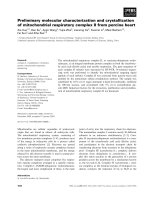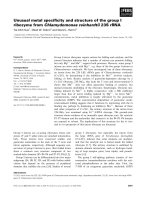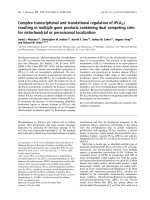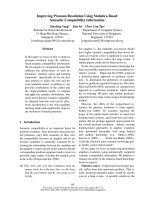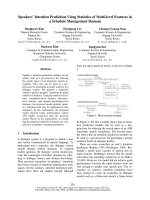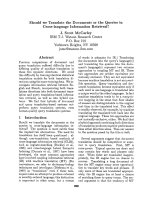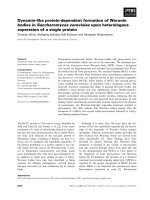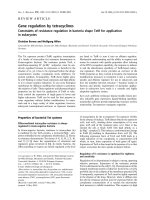Báo cáo khoa học: "Speakers’ Intention Prediction Using Statistics of Multi-level Features in a Schedule Management Domain" ppt
Bạn đang xem bản rút gọn của tài liệu. Xem và tải ngay bản đầy đủ của tài liệu tại đây (81.66 KB, 4 trang )
Proceedings of ACL-08: HLT, Short Papers (Companion Volume), pages 229–232,
Columbus, Ohio, USA, June 2008.
c
2008 Association for Computational Linguistics
Speakers’ Intention Prediction Using Statistics of Multi-level Features in
a Schedule Management Domain
Donghyun Kim
Hyunjung Lee
Choong-Nyoung Seon
Diquest Research Center Computer Science & Engineering
Computer Science & Engineering
Diquest Inc. Sogang University Sogang University
Seoul, Korea Seoul, Korea Seoul, Korea
k
Harksoo Kim
Jungyun Seo
Computer & Communications Engineering
Computer Science & Engineering
Kangwon National University Sogang University
Chuncheon, Korea Seoul, Korea
Abstract
Speaker’s intention prediction modules can be
widely used as a pre-processor for reducing
the search space of an automatic speech re-
cognizer. They also can be used as a pre-
processor for generating a proper sentence in a
dialogue system. We propose a statistical
model to predict speakers’ intentions by using
multi-level features. Using the multi-level fea-
tures (morpheme-level features, discourse-
level features, and domain knowledge-level
features), the proposed model predicts speak-
ers’ intentions that may be implicated in next
utterances. In the experiments, the proposed
model showed better performances (about
29% higher accuracies) than the previous
model. Based on the experiments, we found
that the proposed multi-level features are very
effective in speaker’s intention prediction.
1 Introduction
A dialogue system is a program in which a user
and system communicate in natural language. To
understand user’s utterance, the dialogue system
should identify his/her intention. To respond
his/her question, the dialogue system should gen-
erate the counterpart of his/her intention by refer-
ring to dialogue history and domain knowledge.
Most previous researches on speakers’ intentions
have been focused on intention identification tech-
niques. On the contrary, intention prediction tech-
niques have been not studied enough although
there are many practical needs, as shown in Figure
1.
When is the changed date?
Response, Timetable-update-dateAsk-ref, Timetable-update-date
It is changed into 4 May.
It is changed into 14 May.
…
Prediction of
user’s intention
Identification of
system’s intention
Reducing the search space
of an ASR
It is changed into 12:40.
The date is changed.
Is it changed into 4 May?
…
It is changed into 4 May.
The result of
speech recognition
Example 1: Prediction of user’s intention
Example 2: Prediction of system’s intention
It is 706-8954.
Ask-confirm, Timetable-insert-phonenumResponse, Timetable-insert-phonenum
Response generation
Is it 706-8954?
Identification of
user’s intention
Prediction of
system’s intention
Figure 1. Motivational example
In Figure 1, the first example shows that an inten-
tion prediction module can be used as a pre-
processor for reducing the search space of an ASR
(automatic speech recognizer). The second exam-
ple shows that an intention prediction module can
be used as a pre-processor for generating a proper
sentence based on dialogue history.
There are some researches on user’s intention
prediction (Ronnie, 1995; Reithinger, 1995). Rei-
thinger’s model used n-grams of speech acts as
input features. Reithinger showed that his model
can reduce the searching complexity of an ASR to
19~60%. However, his model did not achieve good
performances because the input features were not
rich enough to predict next speech acts. The re-
searches on system’s intention prediction have
been treated as a part of researches on dialogue
models such as a finite-state model, a frame-based
229
model (Goddeau, 1996), and a plan-based model
(Litman, 1987). However, a finite-state model has
a weak point that dialogue flows should be prede-
fined. Although a plan-based model can manage
complex dialogue phenomena using plan inference,
a plan-based model is not easy to be applied to the
real world applications because it is difficult to
maintain plan recipes. In this paper, we propose a
statistical model to reliably predict both user’s in-
tention and system’s intention in a schedule man-
agement domain. The proposed model determines
speakers’ intentions by using various levels of lin-
guistic features such as clue words, previous inten-
tions, and a current state of a domain frame.
2 Statistical prediction of speakers’ inten-
tions
2.1 Generalization of speakers’ intentions
In a goal-oriented dialogue, speaker’s intention can
be represented by a semantic form that consists of
a speech act and a concept sequence (Levin, 2003).
In the semantic form, the speech act represents the
general intention expressed in an utterance, and the
concept sequence captures the semantic focus of
the utterance.
Table 1. Speech acts and their meanings
Speech act
Description
Greeting The opening greeting of a dialogue
Expressive
The closing greeting of a dialogue
Opening Sentences for opening a goal-oriented dialogue
Ask-ref WH-questions
Ask-if YN-questions
Response
Responses of questions or requesting actions
Request Declarative sentences for requesting actions
Ask-
confirm
Questions for confirming the previous actions
Confirm Reponses of ask-confirm
Inform Declarative sentences for giving some information
Accept Agreement
Table 2. Basic concepts in a schedule management
domain.
Table name
Operation name
Field name
Timetable
Insert, Delete,
Select, Update
Agent, Date, Day-of-week
,
Time, Person, Place
Alarm
Insert, Delete,
Select, Update
Date, Time
Based on these assumptions, we define 11 domain-
independent speech acts, as shown in Table 1, and
53 domain-dependent concept sequences according
to a three-layer annotation scheme (i.e. Fully con-
necting basic concepts with bar symbols) (Kim,
2007) based on Table 2. Then, we generalize
speaker’s intention into a pair of a speech act and a
concept sequence. In the remains of this paper, we
call a pair of a speech act and a concept sequence)
an intention.
2.2 Intention prediction model
Given n utterances
n
U
,1
in a dialogue, let
1+n
SI
de-
note speaker’s intention of the n+1th utterance.
Then, the intention prediction model can be for-
mally defined as the following equation:
)|,(maxarg)|(
,111
,
,11
11
nnn
CSSA
nn
UCSSAPUSIP
nn
+++
++
≈
(1)
In Equation (1),
1+n
SA
and
1+n
CS
are the speech act
and the concept sequence of the n+1th utterance,
respectively. Based on the assumption that the
concept sequences are independent of the speech
acts, we can rewrite Equation (1) as Equation (2).
)|()|(maxarg)|(
,11,11
,
,11
11
nnnn
CSSA
nn
UCSPUSAPUSIP
nn
+++
++
≈
(2)
In Equation (2), it is impossible to directly com-
pute
)|(
,11 nn
USAP
+
and
)|(
,11 nn
UCSP
+
because a speaker
expresses identical contents with various surface
forms of n sentences according to a personal lin-
guistic sense in a real dialogue. To overcome this
problem, we assume that n utterances in a dialogue
can be generalized by a set of linguistic features
containing various observations from the first ut-
terance to the nth utterance. Therefore, we simplify
Equation (2) by using a linguistic feature set
1+n
FS
(a set of features that are accumulated from the
first utterance to nth utterance) for predicting the
n+1th intention, as shown in Equation (3).
)|()|(maxarg)|(
1111
,
,11
11
+++++
++
≈
nnnn
CSSA
nn
FSCSPFSSAPUSIP
nn
(3)
All terms of the right hand side in Equation (3) are
represented by conditional probabilities given a
various feature values. These conditional probabili-
ties can be effectively evaluated by CRFs (condi-
tional random fields) (Lafferty, 2001) that globally
consider transition probabilities from the first ut-
230
terance to the n+1th utterance, as shown in Equa-
tion (4).
)),(exp(
)(
1
)|(
)),(exp(
)(
1
)|(
1
1
1,1
1,11,1
1
1
1,1
1,11,1
+
=
+
++
+
=
+
++
=
=
n
i j
iijj
n
nnCRF
n
i j
iijj
n
nnCRF
FSCSF
FSZ
FSCSP
FSSAF
FSZ
FSSAP
λ
λ
(4)
In Equation (4),
),(
iij
FSSAF
and
),(
iij
FSCSF
are fea-
ture functions for predicting the speech act and the
concept sequence of the ith utterance, respectively.
)(FSZ
is a normalization factor. The feature func-
tions receive binary values (i.e. zero or one) ac-
cording to absence or existence of each feature.
2.3 Multi-level features
The proposed model uses multi-level features as
input values of the feature functions in Equation
(4). The followings give the details of the proposed
multi-level features.
• Morpheme-level feature: Sometimes a few
words in a current utterance give important
clues to predict an intention of a next utterance.
We propose two types of morpheme-level fea-
tures that are extracted from a current utterance:
One is lexical features (content words annotated
with parts-of-speech) and the other is POS fea-
tures (part-of-speech bi-grams of all words in
an utterance). To obtain the morpheme-level
features, we use a conventional morphological
analyzer. Then, we remove non-informative
feature values by using a well-known
2
χ
statis-
tic because the previous works in document
classification have shown that effective feature
selection can increase precisions (Yang, 1997).
• Discourse-level feature: An intention of a cur-
rent utterance affects that dialogue participants
determine intentions of next utterances because
a dialogue consists of utterances that are se-
quentially associated with each other. We pro-
pose discourse-level features (bigrams of
speakers’ intentions; a pair of a current inten-
tion and a next intention) that are extracted
from a sequence of utterances in a current di-
alogue.
• Domain knowledge-level feature: In a goal-
oriented dialogue, dialogue participants accom-
plish a given task by using shared domain
knowledge. Since a frame-based model is more
flexible than a finite-state model and is more
easy-implementable than a plan-based model,
we adopt the frame-based model in order to de-
scribe domain knowledge. We propose two
types of domain knowledge-level features; slot-
modification features and slot-retrieval features.
The slot-modification features represent which
slots are filled with suitable items, and the slot-
retrieval features represent which slots are
looked up. The slot-modification features and
the slot-retrieval features are represented by bi-
nary notation. In the slot-modification features,
‘1’ means that the slot is filled with a proper
item, and ‘0’ means that the slot is empty. In
the slot-retrieval features, ‘1’ means that the
slot is looked up one or more times. To obtain
domain knowledge-level features, we prede-
fined speakers’ intentions associated with slot
modification (e.g. ‘response & timetable-
update-date’) and slot retrieval (e.g. ‘request &
timetable-select-date’), respectively. Then, we
automatically generated domain knowledge-
level features by looking up the predefined in-
tentions at each dialogue step.
3 Evaluation
3.1 Data sets and experimental settings
We collected a Korean dialogue corpus simulated
in a schedule management domain such as ap-
pointment scheduling and alarm setting. The dialo-
gue corpus consists of 956 dialogues, 21,336
utterances (22.3 utterances per dialogue). Each
utterance in dialogues was manually annotated
with speech acts and concept sequences. The ma-
nual tagging of speech acts and concept sequences
was done by five graduate students with the know-
ledge of a dialogue analysis and post-processed by
a student in a doctoral course for consistency. To
experiment the proposed model, we divided the
annotated messages into the training corpus and
the testing corpus by a ratio of four (764 dialogues)
to one (192 dialogues). Then, we performed 5-fold
cross validation. We used training factors of CRFs
as L-BGFS and Gaussian Prior.
3.2 Experimental results
Table 3 and Table 4 show the accuracies of the
proposed model in speech act prediction and con-
cept sequence prediction, respectively.
231
Table 3. The accuracies of speech act prediction
Features Accuracy-S (%)
Accuracy-U (%)
Morpheme-level
features
76.51 72.01
Discourse-level
features
87.31 72.80
Domain know-
ledge-level feature
63.44 49.03
All features 88.11 76.25
Table 4. The accuracies of concept sequence pre-
diction
Features Accuracy-S (%)
Accuracy-U (%)
Morpheme-level
features
66.35 59.40
Discourse-level
features
86.56 62.62
Domain know-
ledge-level feature
37.68 49.03
All features 87.19 64.21
In Table 3 and Table 4, Accuracy-S means the ac-
curacy of system’s intention prediction, and Accu-
racy-U means the accuracy of user’s intention
prediction. Based on these experimental results, we
found that multi-level features include different
types of information and cooperation of the multi-
level features brings synergy effect. We also found
the degree of feature importance in intention pre-
diction (i.e. discourse level features > morpheme-
level features > domain knowledge-level features).
To evaluate the proposed model, we compare
the accuracies of the proposed model with those of
Reithinger’s model (Reithinger, 1995) by using the
same training and test corpus, as shown in Table 5.
Table 5. The comparison of accuracies
Speaker
Type
Reithinger’s
model
The proposed
model
System
Speech act 43.37 88.11
Concept sequence
68.06 87.19
User
Speech act 37.59 76.25
Concept sequence
49.48 64.21
As shown in Table 5, the proposed model outper-
formed Reithinger’s model in all kinds of predic-
tions. We think that the differences between
accuracies were mainly caused by input features:
The proposed model showed similar accuracies to
Reithinger’s model when it used only domain
knowledge-level features.
4 Conclusion
We proposed a statistical prediction model of
speakers’ intentions using multi-level features. The
model uses three levels (a morpheme level, a dis-
course level, and a domain knowledge level) of
features as input features of the statistical model
based on CRFs. In the experiments, the proposed
model showed better performances than the pre-
vious model. Based on the experiments, we found
that the proposed multi-level features are very ef-
fective in speaker’s intention prediction.
Acknowledgments
This research (paper) was performed for the Intel-
ligent Robotics Development Program, one of the
21st Century Frontier R&D Programs funded by
the Ministry of Commerce, Industry and Energy of
Korea.
References
D
. Goddeau, H. Meng, J. Polifroni, S. Seneff, and S.
Busayapongchai. 1996. “A Form-Based Dialogue
Manager for Spoken Language Applications”, Pro-
ceedings of International Conference on Spoken
Language Processing, 701-704.
D. Litman and J. Allen. 1987. A Plan Recognition Mod-
el for Subdialogues in Conversations, Cognitive
Science, 11:163-200.
H. Kim. 2007. A Dialogue-based NLIDB System in a
Schedule Management Domain: About the method to
Find User’s Intentions, Lecture Notes in Computer
Science, 4362:869-877.
J. Lafferty, A. McCallum, and F. Pereira. 2001. “Condi-
tional Random Fields: Probabilistic Models for Seg-
menting And Labeling Sequence Data”, Proceedings
of ICML, 282-289.
L. Levin, C. Langley, A. Lavie, D. Gates, D. Wallace,
and K. Peterson. 2003. “Domain Specific Speech
Acts for Spoken Language Translation”, Proceedings
of the 4th SIGdial Workshop on Discourse and Di-
alogue.
N. Reithinger and E. Maier. 1995. “Utilizing Statistical
Dialog Act Processing in VerbMobil”, Proceedings
of ACL, 116-121.
R. W. Smith and D. R. Hipp, 1995. Spoken Natural
Language Dialogue Systems: A Practical Approach,
Oxford University Press.
Y. Yang and J. Pedersen. 1997. “A Comparative Study
on Feature Selection in Text Categorization”, Pro-
ceedings of the 14th International Conference on
Machine Learning.
232
